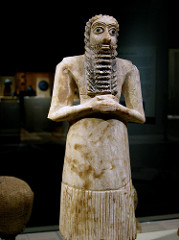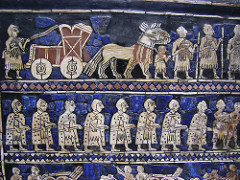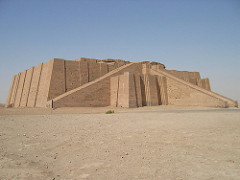Title: Ruins and the Plan of the Anu Ziggurat and White Temple
Artist: Sumerians
Period/Style:
Date: 3300-3,000 BCE
Patron:
Original Location: uruk (Present-day Warka, Iraq)
Material:
Subject: Temple/Ziggurat
Technique & Description: Ziggurat--stepped structure with a temple on top; large chamber containing alter and smaller spaces on each side; White Temple built on top of platform
Context: Meeting place for humans and gods; Statues for gods and donors were placed inside temples
Meaning: Worshipping gods--first Sumerian city-state. Dedicated to Inanna (goddess of love and war) and to Anu (sky god)--uneasiness with gods (nature/climate and other groups)
Ruins and the Plan of the Anu Ziggurat
Title: Carved Vessel from Uruk
Artist: Sumerians
Period/Style:
Date: 3000 BCE
Patron:
Original Location: Iraq
Material: Alabaster (a fine, white stone)
Subject: Vessel depicting stories of Sumerians delivering gifts
Technique & Description: Hieratic Scale; Composite Perspective; Registers; Lowest register- sources of life in the natural world, animals; Middle register- naked men carrying baskets of food; Top register- Inanna accepts an offering from two standing figures; ceremonially dressed figure
Context: Placed in temple, showing loyalty to gods
Meaning: Time of uneasiness with their gods; giving gifts and trying to win favor
Carved Vessel from Uruk
Title: Sumerian Votive Figures
Artist: Sumerians
Period/Style:
Date: 2900-2600 BCE
Patron:
Original Location: Square Temple, Eshnunna (Iraq)
Material: Limestone, alabaster, and gypsum
Subject: Figures of men and women with wide eyes
Technique & Description: Stylized faces an diodes, dressed in clothing that represents pure cylindrical shapes. Solemnly, hands clasped, bold wide eyes; female figures as massive as the men
Context: Placed in temples towards alters of gods
Meaning: People could have these figures made and placed in temples--state of perpetual prayer; approaching the gods with awe
Title: Standard of Ur
Artist: Sumerians
Period/Style:
Date: 2600 BCE
Patron:
Original Location: Iraq
Material: 3-dimensional trapezoid.
Subject: 2, 3-register panels of victory of war and then celebration
Technique & Description: 1st Panel Victory of War--1st register: big man going outside register/narrative. 2nd register: naked prisoners of war. 3rd register: chariots and horses trampling people. 2nd Panel Celebration of Victory--1st register: Big man, party, music, drinking. 2nd register: Bringing food to the party. 3rd register: Getting the food to bring to the party (Maybe the defeated paying taxes)
Context: Time of interaction/aggression with other groups/city-states
Meaning:
Title: Ziggurat of Ur (Nanna Ziggurat)
Artist: Sumerians
Period/Style:
Date: 2100-2050 BCE
Patron: Leader= King Urnammu of Ur
Original Location: Ur (Iraq)
Material: Mud-brick
Subject: Ziggurat dedicated to moon god Nanna (also called Sin)
Technique & Description: Foundation is ziggurat (temple on top); Sloped to prevent rainwater from forming puddles
Context: Built to impress! Only divine have such architecture! Inside holds votive figures, offerings and images of divine. Performance space on top; figures and priests inside (sacred space)
Meaning: Reaching towards heavens, performance and ritual-->project power and authority






